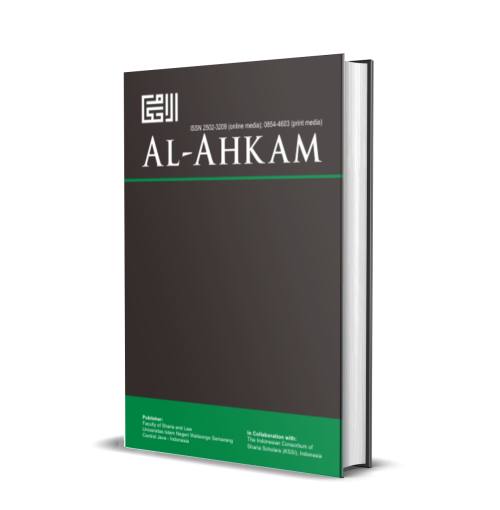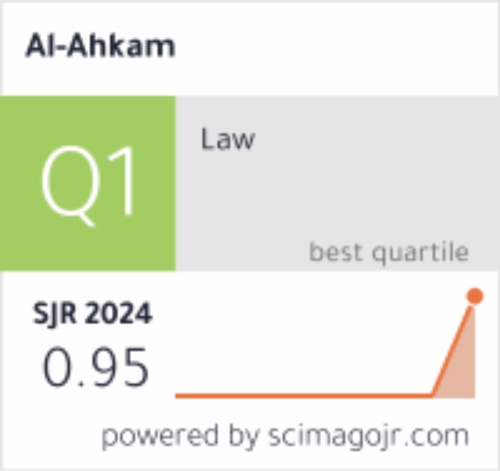ṬULŪ’ AL-HILĀL Rekonstruksi Konsep Dasar Hilāl
DOI:
https://doi.org/10.21580/ahkam.2014.24.2.149Keywords:
sebab normatif, sabit naik (ṭulū‘ al-hilāl), konjungsi, struktur logis, hilālAbstract
This paper intends to review the basic concepts of crescent issue as the most fundamental concepts of the Hijri calendar systems. The crescent basic concept of ṭulū‘ al-hilāl, based on these principles: first, put the crescent as a matter of objective existence does not depend on the subject or observer, but the object itself. Second, the lower moon extremity as a conceptual reference for basic concepts. Third, the beginning of the lunar calender is based on crescent moon rising. This paper also tries to determine the cause of the beginning of lunar calender with the normative traditions of the prophet to analyze the visual sighting of the crescent and istikmāl from the philosophy of Islamic Law’s point of view. Normative cause of fasting Ramadan is not obligatory visual sighting of the crescent of Ramadan, but the rising of the crescent (ṭulū‘ al-hilāl). Visual sighting of the crescent and istikmāl and also Astronomy is a way to find out and make sure that the cause has occurred and they are not the cause by itselfDownloads
References
‘Ābidīn, Ḥāshiyah Radd Ibn, al-Mukhtār ‘ala ’l-Durr al-Mukhtār Sharḥ Tanwīr al-Abṣār Fiqh Abū Ḥanīfah, juz 2, t.t.p.: 2000.
Aḥmad, Ibn Ḥanbal, Musnad Aḥmad, t.t.p.: Mawqi’ Wizārāt al-Auqāf al-Miṣriyah, t.th.
‘Aṣur, Muḥammad al-Tāhir Ibn, al-Tahrīr wa ’l-Tanwīr, Juz 1, t.t.p.: Dār al-Tunīsiyyah li an-Nasr, 1997.
al-Bukharī, Muḥammad ibn Ismā’īl, al-Jāmī’ al-Ṣāḥīḥ, Beirut: Dār Ibn Kathīr, 1987.
Fāris, Abī al-Ḥusayn Aḥmad Ibn, Maqāyis al-Lughah, Juz 6, t.t.p.: Ittiḥād al-Kitāb al-‘Arab, 2002.
al-Ḥalabī, As-Samīn, al-Dur al-Masūn fī ‘Ilm al-Kitāb al-Maknūn, Juz 1, t.t.p.: t.th.
Ibn Manzūr, Muḥammad ibnu Makrūm, Lisān al-‘Arab, Beirut: Dār Sādir, t.th.
Ilyas, Muhammad, Astronomy of Islamic Calendar, Kuala Lumpur: AS Noordeen, 1997.
al-Jazā’irī, Abū Bakar Aysār, al-Tafāsīr li Kalām al-‘Aliy al-Kabīr, Juz 1, t.t.p.: 2003.
Keputusan Lokakarya “Mencari Format Kriteria Awal Bulan Hijriyah di Indonesia 2011” diadakan di Hotel USSU Bogor pada tanggal 19-21 September 2011.
Khafid, Software Mawaqit 2001
al-Khāzin, ‘Alauddin ‘Aliy ibn Muḥammad, Tafsīr al-Khāzin al-Lubāb al-Ta’wīl fī Ma’ānī al-Tanzīl, t.t.p.: 1979.
Malik, Ibn Anas ibn, al-Mudawwanah al-Kubrā, juz 1, Beirut: Dār al-Kutub al-‘Ilmiyyah, t.th.
Malik, Ibn Anas ibn, al-Muwaṭṭa’, t.t.p.: Mawqi’ Wizārāt al-Awqaf al-Miṣriyyah, t.th.
Moore, Sir Patrick (ed.), Philip’s Astronomy Encyclopedia, London: Philip’s Group, 2002.
Moulton, Forest Ray, An Introduction to Astronomy, New York: The Mac Millan Company, 1916.
Muslim, Abū al-Husayn ibnu al-Ḥajjāj, al-Jāmi’ al-Ṣaḥīḥ, Beirut: Dār al-Jayl, t.th.
al-Nasā’ī, Abu Abd al-Raḥman, Sunan al-Nasā’ī, Mawqi’ Wizārāt al-Awqāf al-Miṣriyyah: t.t.p., t.th.
al-Nawāwī, Abū Zakariyya Yaḥyā ibn Sharaf, al-Majmū’ Sharḥ al-Muhādhdhab, Kairo: Dār Ihyā’ at-Turāth al-‘Arabī, 1422.
al-Qarafī, Ṣihābuddin Aḥmad ibn Idris, adh-Dhākirah, juz 2, Beirut: Dār al-Gharb, 1994.
Qa’lahjī, Muḥammad Rowas, Mu’jam Lughāt al-Fuqahā’, Beirut: Dār an-Nafā’is, 1988.
Richards, E.G., Mapping Time: the Calendar and Its History, New York: Oxford University Press, 199.
Ridpath, Ian, Oxford Dictionary of Astronomy, New York: Oxford University Press, 1997.
Shākir, Aḥmad Muḥammad, ‘Awā’il al-Shuhūr al-‘Arabiyyah Hal Yajūzu Shar’an Ithbātuhā bi ’l-Hisāb al-Falakiy, Kairo: Makabah Ibn Taymiyah, 1407.
al-Shāṭibī, Ibrāhim ibn Mūsā ibn Muḥammad, al-Muwāfaqāt, t.t.p.: Dār Ibn ‘Affān, 1997.
Tim Majelis Tarjih dan Tajdid PP Muhammdiyah, Pedoman Hisab Muhammadiyah, Yogyakarta: Majelis Tarjih dan Tajdid Muhammadiyah, 2009.
Downloads
Published
How to Cite
Issue
Section
License
By submitting an article to the journal, the author(s) agree to transfer the published article's copyright to the journal, which will act as the publisher. This means the journal will have the right to publish the article in various forms, including reprints. The journal will maintain the publishing rights to the published articles.
In line with the license, authors and third parties (readers, researchers, and others) are allowed to share and adapt the material. In addition, the material must be given appropriate credit, provided with a link to the license, and indicated if changes were made. If authors remix, transform or build upon the material, authors must distribute their contributions under the same license as the original.




